#Midland Railway
Text
What is the 'Engine Rulebook' and where did it come from?:
So, this really early era of railways was a bit insane, and I am not quite well-versed enough to make a case-study out of everything - but like with my Big 4 scrap post, this is more about trends than singular examples - though some do appear.
The 'Engine Rulebook' is basically the set of rules that every engine ever is taught when built. It's a series of important rules, customs and doctrine used by managers to keep engines in line. Yes, I will use a little business-management theory in here, because early management styles have a major effect. And every railway has its own rulebook that may have differences. But there are a few key things in the 'Engine Rulebook' that I see being universal:
1: The company comes first. This is basically the company ensuring loyalty by indoctrinating the engine to see its railway company as the most important aspect of their life. In the Railway Series, Donald and Douglas have very strong ties back to Scotland and the Caledonian railway - which is why they enjoy blue so much. It's the Caledonian Railway colour! And then there's Duck - who literally continues to wear his GWR colours even after joining the NWR. He's deeply connected to the GWR because of this loyalty taught to him.

2: Railway rules. This includes signalling, signage, speed limits, whistles and their uses, headcodes, flags and every other piece of railway rules. They are read the rulebook, and learn everything in it. It's vital! Percy is an industrial engine who is never taught this rulebook - because industries don't have many engines and often pilfer bits from a bigger company's - and thus Percy doesn't know much about the rules of being on a railway when he arrives on Sodor.

3: Etiquette (based on duty). Now, I don't mean bowing or curtseying or the proper fork for fish - I mean the ins and outs of the duty the engine will be expected to complete. Passenger engines learn how to handle coaches and speak politely to passengers, freight engines learn how to handle trucks and look after different cargos, shunting engines learn a new set of rules for the yards - this sort of thing. Gordon struggles with trucks because he was never taught how to handle them.

4: The managers are always right. Touched on this in a reblog of this @mean-scarlet-deceiver ramble, but its basically that the engines are taught that their managers are right in all contexts (unless breaking one of the above rules) and need to be respected and have all directions followed. The manager says to shunt - you go and shunt. They say to go get scrapped - and a good engine listens without hesitation. Doesn't work out in real life all the time - see Oliver, or the Big Engines' strike - but it definitely keeps most engines in line.
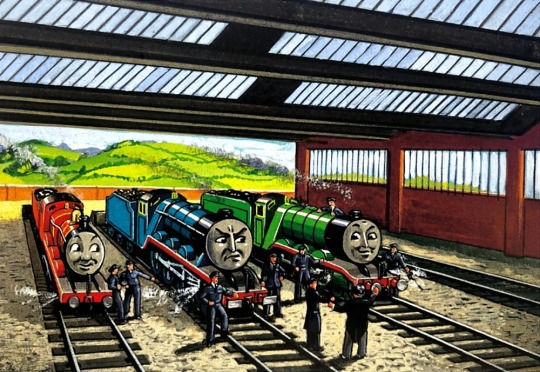
So we have these four core rules - but where did they come from? Well...
Regency Era Railways:
Straight off the bat - this is the era where every railway is figuring itself out. The L&MR was where everything was forged in fire - before it, the only railways that existed were isolated plateways in mines and the Stockton & Darlington Railway. None of these were anywhere near as complex as the L&MR, which is really the first railway 'system' in the way we might understand today. It's also where the first sentient engines begin to make a proper appearance and have an effect on people. Before, they were hidden in mines, if they existed at all - but now the public can see them!

Like, imagine this rocks up to collect you in an era when the most advanced method of transport is literally a horse. And it has a face. Remember, in this period people though that if they went over a certain speed or through a tunnel they would explode - so now the thing that might just kill them has a face?!
Managers would very quickly begin implementing ways to soothe their passengers. One way of doing that would be to dehumanise the engines - I can see many early engines being given basically no education because they are both seen as being 'working class' and because they are machines. When Rocket first ran, there were no public schools.
In this era, engines didn't know much, and they were isolated on their little systems. Yard managers are one of the few people with authority that these engines meet on a regular basis, and they use this to their advantage and cultivate this idea that the engines are entirely subservient to them. This is where that manager loyalty begins to become apparent - just not quite in its modern form.
The only education an engine would get is how to be loyal. Why should they learn signals, or passenger etiquette, or how to read? That is a driver or a guard's job. And so this really early era is characterised by dehumanisation and a lot of public-relations officers doing their best to downgrade the sentience of the engines. It's a lot of "yes they have a face, no they don't have intelligence, don't worry". This does extend into the Victorian era, as seen in Very Old Engines, as Skarloey arrives on Sodor with some principles taught at the workshop, only to be met with "you don't have rights, do your job." Which he naturally rebels at and then gets covered in a tarp for his troubles.
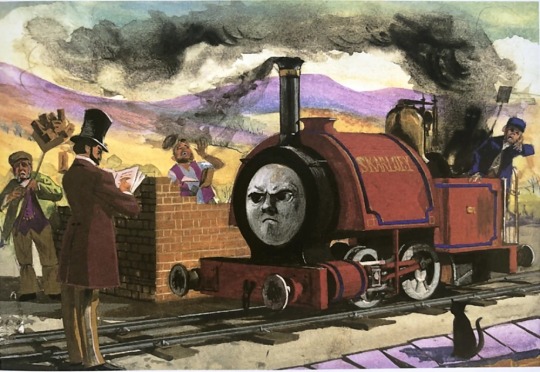
Of course, the Regency Era ends very soon into railway history, and just in time for a major game-changer.
The Victorian Era:
1838 is the year the first GWR train runs, and this railway in the South-west of England will have a huge impact on all railways that come after. First, the entire board of directors are very elitist and influential in parliament. This is a railway that needs to live up to its owners.
It is the GWR, not the L&MR, that writes the first book on engine learning. It's also the GWR, and not any other railway in the UK, that first develops a proper corporate culture for its engines that they actually like. The GWR does this by actually treating the engines like they have sentience.

Engines like Iron Duke are introduced to the 'Great Western Way' - this being the rulebook that Brunel and Gooch develop to best serve their wealthy owners. These engines are taught to read, understand the rules of the railway, passenger etiquette - which by now can be taught because there's less fumbling around blindly - and perhaps most importantly: they are taught a very proud mindset. The railway is the most important aspect of their lives, and they are to serve it to the best of their ability. All four of the rules appear in their first form here, except that the etiquette is not entirely based on duty, and instead all engines are taught all jobs - which horrified much of the rest of the railway companies.
But while this is going on on the GWR, the rest of the country's railways were trying to survive a crisis. Railway Mania swept Britain, and hundreds of engines and built (and destroyed) by the week. One thousand bills for new railways were submitted to parliament during this period, and while not all were built - it certainly had an impact. The LNWR was formed during this period, chunks of the Midland Railway, NER, GNR, GCR, Caledonian and basically every other major railway were all constructed in this time frame - but that didn't mean a drastic improvement in how the engines were treated in this area. Many North-western railways were influenced by the thinking from the L&MR, leading to entire fleets of early engines having zero clue how to act or even speak in some cases. When the bubble collapsed, many engines were scrapped - and this is where the other extremely important pillar stone of railway doctrine was introduced: engines are expendable, and should not want to hinder a company. The fourth rule is set into stone here, and goes unchanged and practically unchallenged all the way into the modern era.

This here, the end of steam in Britain, is able to happen because of principles introduced during Railway Mania. British Railways uses this rulebook and the laws that most likely surround it by this point to justify their actions, and also because thanks to this rulebook very few engines have the vague notion or idea to protest. Why would they, it goes against the rules!
The eradication of steam is almost directly caused by the era of Railway Mania and the principles managers introduced in the era to protect their profit margins. Without that doctrine, engines would have had a lot more rights and a lot more ability to protest being scrapped.
In other words, the 1840's was when scrapping began to appear properly, as well as the explosions, derailments and every other crash from the previous generation. Engines became unfeeling in this era - in the north at least. The GWR escaped this by being... well, not an economic bubble.
However, as the British Isles emerges from Railway Mania, two very strong railways vie for influence: the LNWR and the GWR. The LNWR has that traditional L&MR mindset - and it leads to a huge problem. The engines begin to learn how to speak from their crews, and moreover they question why their GWR counterparts are treated so much better. The LNWR also suffers from a number of easily preventable accidents caused by the engine having zero clue what to do.
Some railways land between the two, and it was the GNR that ended up formulating the four rules in their next evolution: engines were only taught their jobs. This was the GNR compromise with their board members. The board wanted a GWR approach, however the actual managers on the ground rebelled, worrying this would lead to the engines working together to demand fairer treatment. The Communist Manifesto was in major circulation at the time, and none of these companies wanted their engines getting any ideas. Instead, they implemented something of a class system, with express engines at the top and shunters at the bottom.
In the TVS, Emily is extremely abrasive towards Thomas (Seasons 8-12), and it may just have to do with the way she was raised, seeing shunters as the lowest form of engine. Gordon certainly did!

These three very distinct practices all melded and fused together on the Midland Railway - which of course ran right in between them all. The Midland Railway wrote the third proper rulebook in 1859, roughly twenty years after the GWR wrote its.
The Midland Railway's rulebook took the LNWR idea that engines needed to be taught to accept death, the GNR idea of a class system and the GWR importance of company loyalty and railway-rule-knowledge and fused them together, being able to create the rulebook that most British railways would use by 1890. The major exception to this was of course the Great Western, which slowly evolved its rulebook to use the LNWR ideas of engines being subservient to their managers while retaining the classless form of etiquette the engines were taught. The GNR would also hold out on some ideas from the GWR until it was amalgamated into the LNER, due to rising fears of Communism by the board.
Many smaller railways, such as the Furness Railway or the Highland Railway in Scotland, would use the GWR style, due to the smaller size of the workforce, and thus the potential necessity for engines to complete duties they were trained for.

Duck fits into his role at Tidmouth with such ease because he knows the theory behind every express train, every freight train, every style of shunting and branchline service. He doesn't need them, but the GWR engines were taught this just in case. Duck is excellent at his job, but he won't take any flak from the other engines because his GWR ideology makes him see them all as equal. This is of course part of the Great Western Way as explained in this post.
In direct contrast, Gordon has zero clue how to pull a freight train, and stalls on the hill because he physically doesn't know what to do.
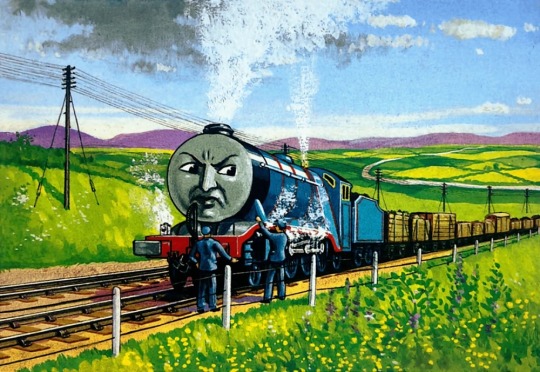
And this brings me quite neatly to Sir Topham Hatt I. See, this is a GWR man who runs a railway that is very heavily influenced by the Midland Railway rulebook ideology. Edward knows how to do multiple tasks because the Furness Railway used GWR practice (maybe that's why he likes Edward?) while none of the other engines do. Sir Topham Hatt's management style using GWR practice is so confusing to them. Why is James - who is mixed-traffic at best - pulling the express? Why is Gordon pulling freight? Why are the big engines shunting?!

And then we have Henry. Sir Topham and Henry have such a rocky relationship, and it in many ways comes from the fact that Henry had none of the formal education that I just discussed. He's a privately-built engine from stolen plans sold cheap. He doesn't actually know the etiquette of a passenger train - no wonder he stops when he doesn't like the weather! He doesn't physically know better, and so he's acting on his first instincts. This clashes so badly with the GWR style which places etiquette almost above everything else. Hatt reacts so badly and outright insanely to this because to him, Henry is actively and deliberately breaking every rule in the book because of his paint? And Henry doesn't have a clue. Look at how horrified he is!

And don't get me wrong, this is extremely unethical and very stupid, but it has a precedence in miscommunication, differing ideologies and Henry's foolishness.
This was another massive ramble with a lot of insanity, but I do enjoy writing these. Helps organise my mind! As usual, none of the above pictures belong to me, and feel free to chuck in a comment with your opinion!
#the 1800s#ttte edward#i need to calm down#thomas the tank engine#railway series#railways#real life railway#what are the rules for trains?#fanfiction writer#ao3 stuff#british rail#british railways#Great Northern Railway#gwr#Midland railway#LNWR#ttte au#sir topham hatt#ttte henry#ttte gordon#ttte skarloey#ttte duck#ttte emily#weirdo shit#long reads#very long post#britain#Great Western way
107 notes
·
View notes
Note
Have you done something about Big Emma/Bertha? (I think she (she had two names, hence why I put that) was designed to be an absolute unit and bank trains up the Lickey Incline?)

Not really, she was really popular for a while, and I've never felt I really had anything special to say about her. She was allocated to Wellsworth following Typhoon being reallocated to Tidmouth, but by 1963 BR attempted to withdraw her.

Before the North Western and British Railways could get into yet another brawl, a preservation group formed to save the engine approached with an offer to purchase her. The offer was unexpectedly large (its suspected the NWR made a generous donation) and BR happily accepted, not even complaining when the 58100 Preservation Group signed a deal with the North Western for her to assist with on their lines when not visting Preservation Lines in turn for taking on her overhuals.
Emma, as she prefers to be called, spends thetourist season touring preservation lines across the United Kingdom, a popular attraction where ever she goes. When not traveling she calls Vicarstown sheds her home, happily working with Typhoon, who she'd became close with during their time together on the Lickey incline.
An iincident of not occured in 2019, when a frieght stalled on the Lickey Incline. Emma had been traveling back towards the North Western following a visit to a heritage line when she was stopped and asked if she would assist. Footage of the 0-10-0 banking a modern train up the incline went viral, and was one of the last major railfan events before lockdown.
#Ask Hazel#Hazel Asks#Hazel Q&A#0-10-0#Big Bertha#Big Emma#Midland Railway#LMS#They're Shedmates your honor
10 notes
·
View notes
Note
Hi yes I am here for this wild and unexpected crossover between two very distinct interests of mine.
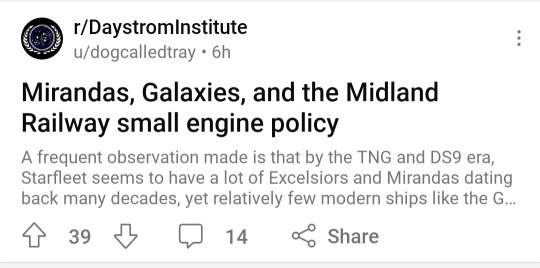
Oh hell yeahhh. Exciting to see the M.R.'s "small engine policy" referenced in the wild, as it were.
The Midland seems to do very well in the sci-fi world, eh? I'm reminded of this painting by Peter Harness for The War of the Worlds (I think it might have been concept art for the T.V. series?) starring an M.R. engine pulling a urgent train of evacuees fleeing the invasion site:
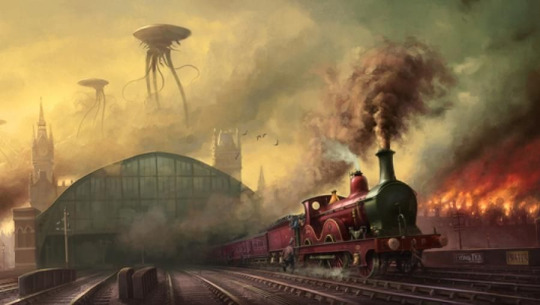
35 notes
·
View notes
Text

Confessing a cursed headcanon cus idk where else to get this out
Sometimes I see Emily as a Midland Railway Johnson 0-4-4 (one of the 1890s classes). I’m fine with her being a Stirling single but sometimes this enters my brain for no reason and it feels like it works even tho it shouldn’t. Maybe it’d even look nice in emerald green.
H E L P
2 notes
·
View notes
Photo
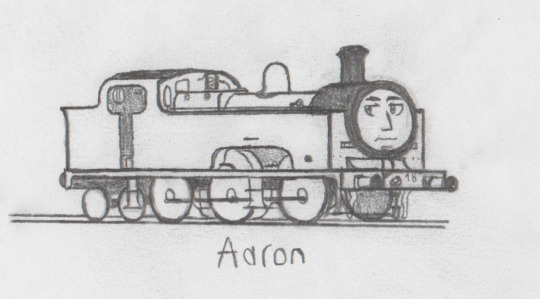
Another one of my ocs I don't draw all that often
This is Aaron! He has anger issues, just a little
#ttte#ttte oc#rws#rws oc#thomas and friends#railway series#oc#original character#midland railway#midland railway flatiron#midland railway 2000 class#traditional art#locomotive#train
2 notes
·
View notes
Text
I've been to another tommy choo choo thing - this time it was the Clearwater weekend :)

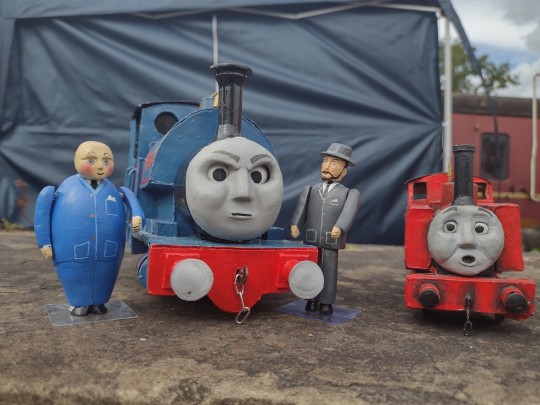


Posed my Ivo with someone else's replicas - plus a Nancy figurine I made for them as a gift!

The same figure with another person's replicas :)


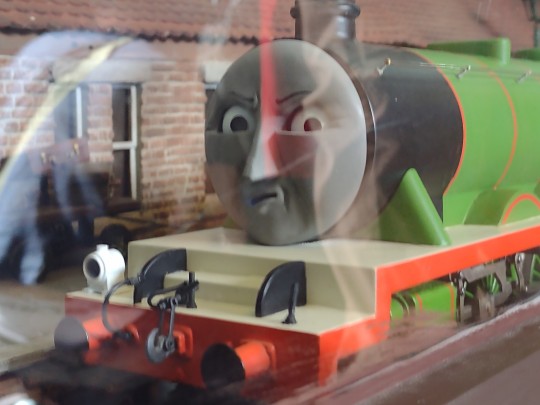

They had a tonne of stuff on display - full thread of all photos is on my twitter.com/dud_spud
Oh yeah also I made a Mid Sodor Railway Manager figurine.

#ttte#thomas the tank engine#skarloey railway#the railway series#trains#ivo hugh#sir handel#butterly#midland railway#clearwater weekend
4 notes
·
View notes
Text
MIDLAND RAILWAY 🚂 Lickey Incline 1958 (AI enhanced) -- banking engines in British parlance; helper locomotives by American nomenclature.
youtube
0 notes
Text

Poster for the London Midland and Scottish Railway Derby Staff Ball (1931).
#vintage poster#1930s#ball#party#dancing#staff ball#dancers#masquerade#derby staff ball#london midland and scottish railway#lms railway#british
58 notes
·
View notes
Text
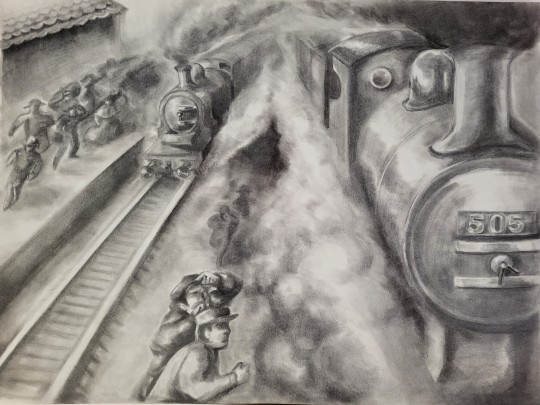
"Runaway on the LMS", 2022, graphite
Close ups:


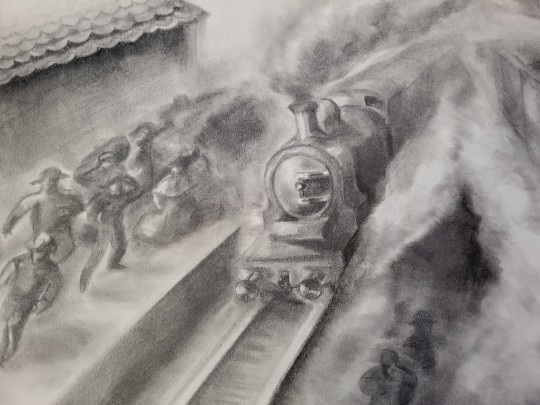
Please do not repost without permission!
#randomly remembered that this existed while i was cleaning my room#and its WAY too good not to post#i worked on it for about 2 weeks maybe 3#and it was for college assignment#the engines have no particular basis but feel free to speculate!!!#humans will always be fucking impossible to shade w graphite istg#real life railway#kips art#art#steam locomotive#london midland and scottish railway#artists on tumblr#traditional art#college artist
227 notes
·
View notes
Text

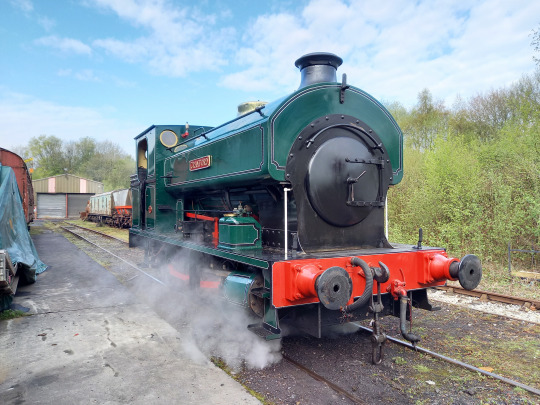


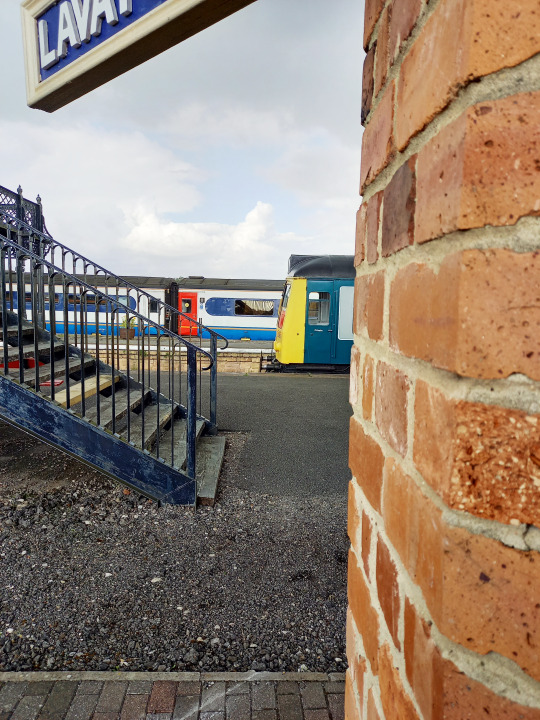


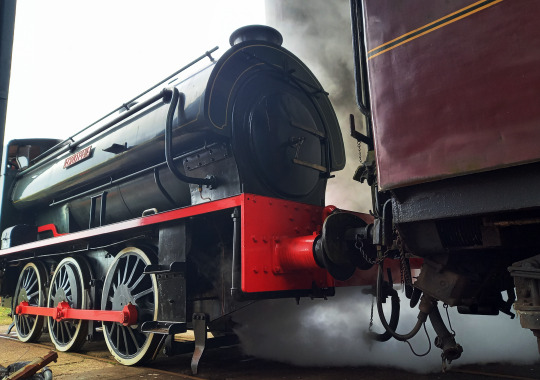


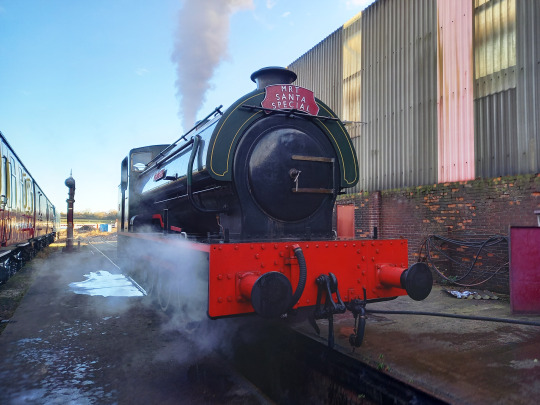
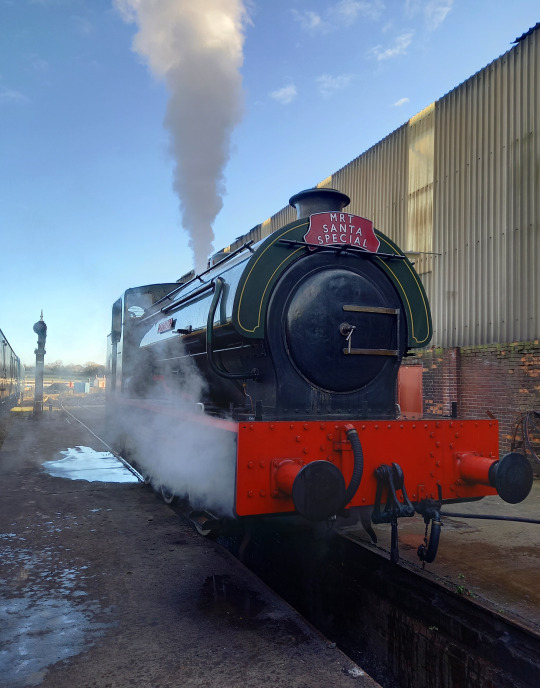
Midland Railway Butterley 2019-2023 (Part 2)
#steam locomotive#england#winter#photography#steam engine#steam train#train#engine#locomotive#LMS#british railways#smoke#steam#photograph#midland railway center#MRC
25 notes
·
View notes
Text
💚Midlander💚

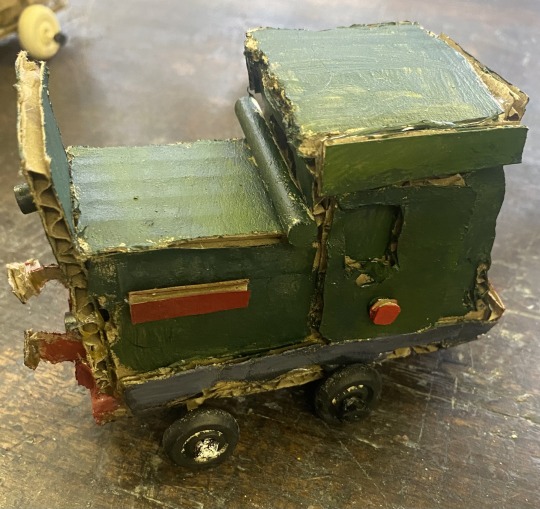
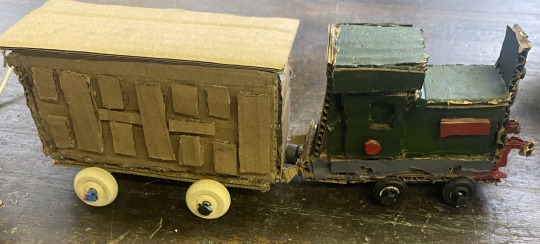


finally finished my midlander model (which I’ll add the final touches like their number and nameplates) and a talyllyn coach that I’ll painted on Monday alongside the second one that I need to finish at least they can roll about and be connected with the magnets
#my art#my artwork#my art <3#my artwrok#my art stuff#techicaply it’s counts as art haga 3d modeling with cardboard is kinda fun#midlander#talyllyn railway#just printed out a bunch of blueprints to copy over with charcoal on cardboard#I kept burning myself with the hot glue gun and having to do it twice but it was so worth it#got these two and the other Coach and the two troublesome trucks that can hold things and switch faces#still finishing my 3/3 art
13 notes
·
View notes
Text


introducing the big four. the main troublemakers. berwyn (GWR) is probably the only one who still has this photo.
ask box is now open as well !
#inbetweenthelines#ibttl4#lner#lms#southern railway#gwr#great western railway#london midland scottish railway#london north eastern railway#ttte#the railway series#railway series#personification#gijinka#thomas the tank engine#thomas and friends#railway#british rail#oc art#digital art
41 notes
·
View notes
Text
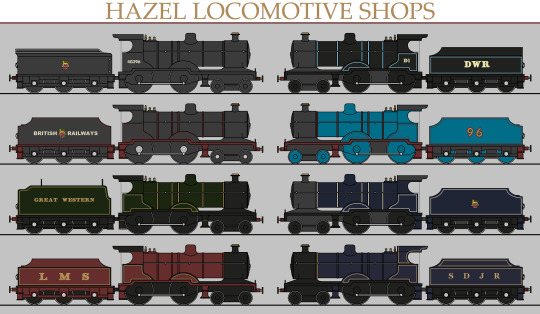
The engine that kicked off my work for the DWR, The Midland 2P.
@denbigh-and-wrexham its your girl.
13 notes
·
View notes
Text
Part 12 in shipping different railway companies together, I guess this, like Part 10 isn't exactly a ship.
May I introduce you to the London Airport Express Group. They aren't a relationship or anything, just a LinkedIn group of airport workers in and around London. They work on a fast, frequent and efficient working.
The group consists of:
Heathrow Express, she is the prestigious and classy one.
Gatwick Express, he does a fast intercity service serving a much larger region out of anyone in the group.
Stansted Express, she is the dedicated in the group but still works well, though doesn't work quite as efficiently.
Other people want to join the group:
East Midlands, who doesn't operate a proper direct service.
Greater Anglia, who doesn't even try to work efficiently.
Elizabeth Line, which does work is kind of accepted as a friend of the group as she was a friend of Heathrow Express' now dead sister (Heathrow Connect).
#heathrow express#gatwick express#stansted express#east midlands railway#greater anglia#elizabeth line#heathrow connect#uk trains#tocsu
7 notes
·
View notes
Text
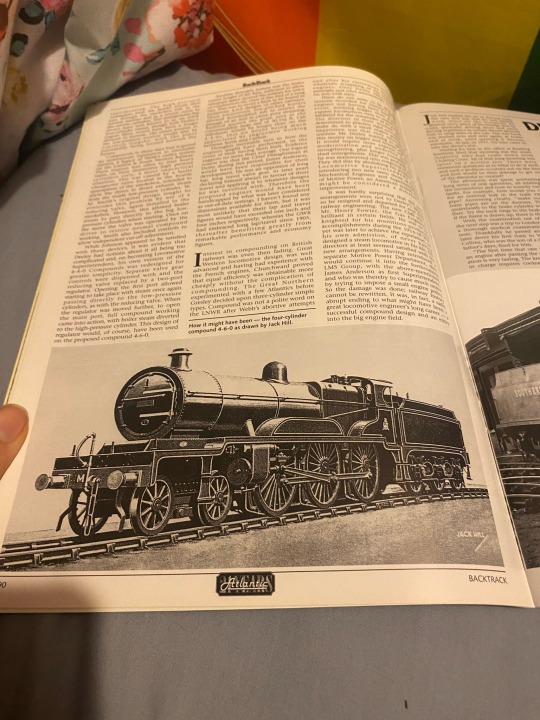

The sort of nearly but ultimately never build deeley compound
1 note
·
View note
Text
The Christmas book tree at St. Pancras Station, London.
It features a staircase which winds up 270 shelves, stocked with over 3,800 hand-painted books.
The little booths at the bottom have speakers that read you a story while you wait for your train. 📖🌲🚂
—
St Pancras Railway Station, also known as London St Pancras or St Pancras International, and officially as London St Pancras International since 2007, is a central London railway terminus on Euston Road in the London Borough of Camden.
St Pancras Station opened in 1868 and is one of the wonders of Victorian engineering.
Along with the former Midland Grand Hotel, it is a masterpiece of Victorian Gothic architecture and one of the most elegant stations in the world.
It was built by the Midland Railway Company (MRC) to connect London with some of England’s major cities and was intended to make a grand statement about the Company with a display of physical magnificence.
#St Pancras Station#St Pancras Railway Station#London St Pancras#St Pancras International#London St Pancras International#Midland Railway Company (MRC)#books#Christmas book tree#train station#London
10 notes
·
View notes